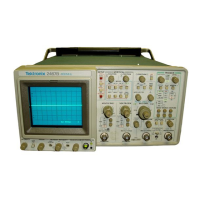Performance Check—2465B/2467B Service
b. Connect a 1 kHz, 2 V standard-amplitude signal from
the Calibration Generator to the CH 1 OR X input connec-
tor and the rear-panel EXT Z-AXIS input connector using a
50 fi BNC T-Connector and two 50
Q
BNC cables.
b. Connect a test oscilloscope to the A GATE OUT
connector (located on the instrument rear panel) via a 50 n
BNC cable.
c. CHECK—The positive portion of the 4-division signal
display is blanked out.
c. CHECK—Test oscilloscope displays a signal with a
high level between 2.4 V and 5 V and a low level between
0 V and 0.4 V.
d.
Disconnect the test setup and adjust the CRT
INTENSITY as desired.
d.
VERIFY—Duration of the high level is between 1 ms
and 1.2 ms.
3. Check A and B GATE Outputs and Verify
TRIGGER HOLDOFF.
a. Set:
A SEC/DIV
B SEC/DIV
At
TRIGGER MODE
HOLDOFF
A REF OR DLY POS
100
MS
50
MS
(knob in)
Off (DLY readout)
AUTO
Minimum (CCW)
Zero DLY readout
e. VERIFY—Duration of the low level is between 80
MS
and 150 MS.
f. VERIFY—Duration of the low level increases to at
least 10 times the time measured in part e when the
HOLDOFF control is rotated to the maximum CW position
but not in the detent.
g.
Move the 50 fi BNC cable from the A GATE OUT
connector to the B GATE OUT connector.
NOTE
On CTT instruments, rotate the A REF OR DLY
POS control for the specified
delay.
As the con-
trol is rotated, the readout delay value will be
fol-
lowed by the word
"SET",
denoting the indirect
measurement mode. A few seconds after control
movement has stopped, the word "SET" will
disappear and the readout will display the direct
measurement from the CTT.
h. CHECK—Test oscilloscope displays a signal with a
high level between 2.4 V and 5 V and a low level between
0 V and 0.4 V.
i. VERIFY—Duration of the high portion of the signal is
between 500
MS
and 600
MS.
j.
Disconnect the test setup.
4-37

